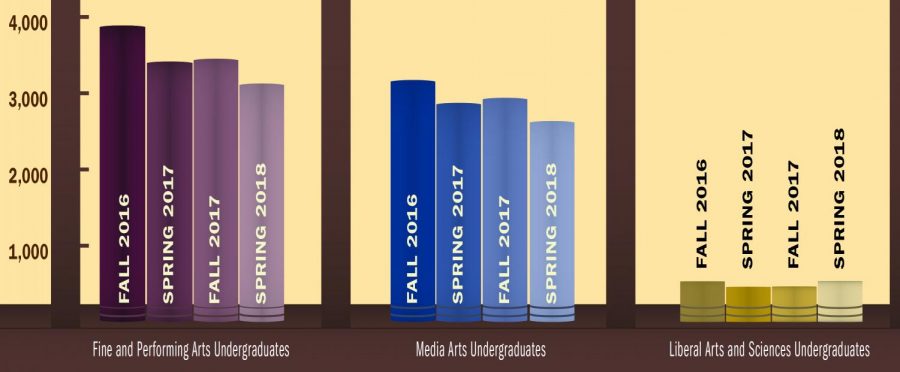Enrollment decline slows
April 2, 2018
Columbia’s spring 2018 enrollment declined 9.1 percent from spring 2017, down 640 students.
However, the percentage decline is less than the 11.4 percent decline Columbia reported from SP16 to SP17 and the 10 percent decline from FA16 to FA17, as reported March 6, 2017, and Oct. 6, 2017, by The Chronicle.
A Census Enrollment Report for spring 2018 released by the Office of Institutional Effectiveness showed this semester’s total enrollment at 6,539, in comparison to last spring’s 7,179.
Enrollment has declined continuously since it began dropping between FA08 and FA09, when the college’s enrollment dropped 384 students. Of the 19 undergraduate departments listed in the report, 11 lost more than 10 percent of their enrollment between SP17 and SP18, five of which lost more than 20 percent. Theatre is the only department that reported an increase in enrollment.
From FA17 to SP18, nine of the undergraduate departments lost more than 10 percent of their enrollment.
Despite the continuous declines, Chief of Staff Laurent Pernot said the college is retaining more freshman students and has seen an increase in transfer and international students.
“We’re seeing some declines, but the declines are decreasing,” Pernot said. “We feel like we’re trending well and early indications [are] that trend will continue into the fall 2018 cycle.”
Departments that experienced steepest enrollment declines from SP17 to SP18 include Science and Mathematics, which lost two of its nine students, a 22 percent drop; Dance, which lost 28 of its 126 students, a 22 percent drop; and Humanities, History and Social Sciences, which lost 16 of its 47 students, a 34 percent drop.
Chair of the Design Department Tim Cozzens said the declining enrollment was expected for various reasons. The department lost 53 of its 599 students, a 9 percent loss.
“We can’t control if a student has the financial means to be able to come back,” Cozzens said. “We can’t control if a student has something happening that makes it hard for them to perform academically and thus have a challenge from returning. We can control access to facilities, and the idea that students are being understood.”
Cozzens said the department has spent the last three years actively trying to engage with Student Government Association to increase communication, so students do not think that their voices are being ignored.
The college has an enrollment strategy group working to increase enrollment, and examine the issue from a variety of perspectives, according to Senior Vice President and Provost Stan Wearden.
The group analyzes financial aid, retention strategies and freshman, transfer and international student recruitment, Wearden said. It is working to increase enrollment in continuing adult education courses with Columbia College Chicago Online, he added.
Pernot said enrollment for SP18 was more than expected, given that the college projected 6,475.
“We look at our trends, applications and where we are with our rate of admission, and that’s the number we use to build a budget. So that’s our assumption [as] to how many students,” Pernot said. “We’re actually over that projection, which is a first for us.”
Colbey Reid, chair of the Fashion Studies Department who joined the college in summer 2017, said the department is working to maintain retention rates by making financial aid more available. The Fashion Studies Department lost 54 of its 482 students, an 11 percent drop.
The department was awarded a $500,000 endowment by the Chicago Fashion Foundation that will go to student scholarships, according to Reid.
Chair of the Communication Department Suzanne McBride said although having higher enrollment is preferable, the college’s graduation and retention rates continue to rise, and the primary focus should be on that.
The Communication Depart-ment lost 59 of its 438 students, a 13 percent decline.
McBride, who has worked at Columbia for more than a decade, said there is always an expected decline in enrollment from fall to spring, and the college has to do a better job of communicating to attract more students.
“[Enrollment] is an issue we are all cognizant of in the department and across the college as we should be,” McBride said. “We all need to be thinking and working on how to make sure we are attracting and retaining the most diverse and creative group of students in all of our disciplines. ”
The chairs of the American Sign Language-English Interpretation, Business and Entrepreneurship, Interactive Arts and Media, and Art and Art History departments did not respond to request for comment as of press time.
Wearden said the flat line of enrollment suggests an upturn in the next coming years.
“We have some challenges right now, [but] I do not feel like we are in any sort of a crisis situation,” Wearden said. “We have got a great leadership team in place at the college both at the cabinet level, at the dean level, as well as the registrar office and in all the right places to turn the enrollment situation at Columbia around.”








